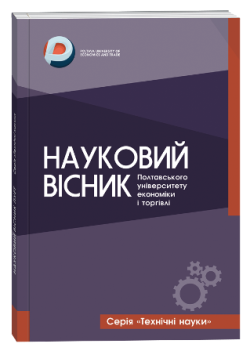ДОСЛІДЖЕННЯ ВПЛИВУ ПЮРЕ ГАРБУЗА НА ЯКІСТЬ БОРОШНЯНИХ ВИРОБІВ
Анотація
Стаття присвячена дослідженню впливу пюре гарбуза на якість борошняних виробів, зокрема булочок. Актуальність дослідження зумовлена зростаючим попитом на функціональні продукти харчування та необхідністю розширення асортименту хлібобулочних виробів з підвищеною харчовою цінністю. У роботі розглянуто сучасні тенденції у використанні рослинних інгредієнтів для збагачення хлібобулочних виробів. Особлива увага приділена гарбузу як перспективній сировині, багатій на пектин, β-каротин, вітаміни та мікроелементи. Авторами обґрунтовано доцільність використання гарбузового пюре для покращення якості та підвищення харчової цінності булочок. Експериментальні дослідження проводилися на основі рецептури булки для бургера. Було розроблено три варіанти дослідних зразків з додаванням 5 %, 10 % та 25 % гарбузового пюре від маси борошна. Контрольним зразком слугувала булочка без додавання пюре. У ході дослідження вивчено вплив різних концентрацій гарбузового пюре на фізико-хімічні та органолептичні показники якості булочок. Зокрема, проаналізовано зміни пористості, вологості, кислотності та питомого об’єму виробів. Результати дослідження показали, що додавання гарбузового пюре позитивно впливає на якість булочок. Встановлено, що пористість виробів зростає на 13,0 ± 0,1 % при додаванні 25 % пюре гарбуза. Виявлено тенденцію до зниження вологості готових виробів на 18,6 ± 0,2 %. Відзначено підвищення кислотності булочок. Органолептична оцінка виявила позитивний вплив гарбузового пюре на зовнішній вигляд, колір, структуру та смак виробів. Дослідження підтверджує перспективність використання пюре гарбуза як функціонального інгредієнта в технології виробництва булочок. Це дозволяє не лише покращити якісні показники виробів, але й збагатити їх корисними речовинами, підвищуючи харчову цінність та функціональні властивості.
Посилання
2. Davydova, O., Cherevychna, N., Kramarenko, D., Sysoieva, S., & Nechepurenko, K. (2023). Formation of quality indicators of products based on fruits and berries. Eastern-European Journal of Enterprise Technologies, 6(11(126)), 73–82. https://doi.org/10.15587/1729-4061.2023.291884
3. Panasiuk, S. H., & Taraymovych, I. V. (2022). Vykorystannia ovochyevo-fruktovykh poroshkiv yak innovatsiinykh inhridiyentiv u retsepturi kraftovykh khlibobulochnykh vyrobiv [Use of vegetable and fruit powders as innovative ingredients in the recipe of craft bakery products]. Tovaroznavchyi visnyk – Commodity Bulletin, 15(2), 49–62. https://doi.org/10.36910/6775-2310-5283-2022-16-4
4. Shanina, O. M., Halyasnyi, I. V., & Lobachova, N. L. (2015). Obhruntuvannia skladu boroshchianoi syrovyny v tekhnolohii bezhliutenovoho bezdrizhdzhovoho khliba [Justification of the composition of flour raw materials in the technology of gluten-free yeast-free bread]. Wschodnioeuropejskie Czasopismo Naukowe – East European Scientific Journal, (4), 56–60.
5. Kozhevnikova, V. O. (2016). Udoskonalennia tekhnolohii khlibobulochnykh vyrobiv z vykorystanniam likarskoi ta priano-aromatychnoi syrovyny [Improvement of bakery products technology using medicinal and aromatic raw materials] (Author’s abstract of the candidate of technical sciences dissertation). Odesa : Odeska natsionalna akademiia kharchovykh tekhnolohii.
6. Obiegbuna, J. (2013). Effect of substituting sugar with date palm pulp meal on the physicochemical, organoleptic and storage properties of bread. African Journal of Food Science, 7(6), 113–119. https://doi.org/10.5897/AJFS2012.0605
7. Pathak, D., Majumdar, J., Raychaudhuri, U., & Chakraborty, R. (2017). Study on enrichment of whole wheat bread quality with the incorporation of tropical fruit by-product. International Food Research Journal, 24(1), 238–246.
8. Kozlov, H., & Karabina, P. (2005). Chasnyk yak dobavka dlia khlibobulochnykh vyrobiv [Garlic as an additive for bakery products]. Khlibopekarska i kondyterska promyslovist Ukrainy – Bakery and Confectionery Industry of Ukraine, (8), 26.
9. Sniezhkin, Yu., & Petrova, Zh. (2004). Poroshky z ovochiv i fruktiv [Vegetable and fruit powders]. Zerno i khlib – Grain and Bread, (7), 38.
10. Zhestereva, N., & Hrehirchak, N. (2005). Roslynni poroshky v khlibi vykorystovuvaty dotsilno [It is advisable to use plant powders in bread]. Zerno i khlib – Grain and Bread, (11), 42.
11. Pakhomska, O. V. (2019). Naukovyi pidkhid do stvorennia khlibobulochnykh vyrobiv funktsionalnoho pryznachennia [Scientific approach to the creation of functional bakery products]. Kharchovi tekhnolohii – Food Technologies, 25(2), 276–283. https://doi.org/10.24263/2225-2924-2019-25-2-30
12. Klopotenko, Ye. (2020). Zbirnyk retseptur strav dlia kharchuvannia ditei shkilnoho viku v orhanizovanykh osvitnikh ta ozdorovchykh zakladakh [Collection of recipes for feeding school-age children in organized educational and health institutions]. Lviv : Litypos.
13. Drobot, V. I. (Ed.). (2015). Tekhnokhimichnyi kontrol syrovyny ta khlibobulochnykh i makaronnykh vyrobiv [Techno-chemical control of raw materials and bakery and pasta products]. Kyiv : Kondor-Vydavnytstvo.


